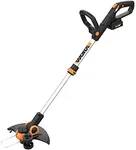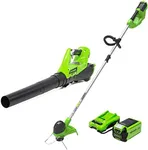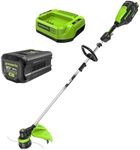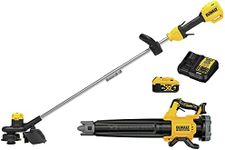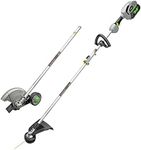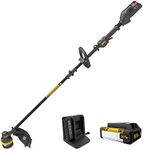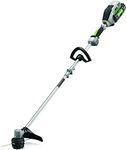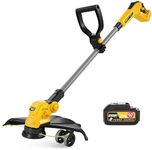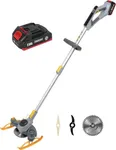Buying Guide for the Best Battery String Trimmers
Choosing the right battery string trimmer can make your yard work much easier and more efficient. Battery string trimmers are convenient because they are cordless, which allows for greater mobility and ease of use. When selecting a battery string trimmer, it's important to consider several key specifications to ensure you get the best fit for your needs. Here are the key specs to look at and how to navigate them.Battery VoltageBattery voltage indicates the power output of the trimmer. Higher voltage generally means more power, which can be useful for tougher trimming tasks. Battery voltages typically range from 18V to 80V. For light trimming and maintenance, a lower voltage (18V-24V) may be sufficient. For medium to heavy-duty tasks, consider a higher voltage (40V-80V) to ensure the trimmer can handle thicker grass and weeds. Choose based on the type of vegetation you need to trim and the size of your yard.
Battery Capacity (Ah)Battery capacity, measured in ampere-hours (Ah), determines how long the trimmer can run on a single charge. Higher capacity batteries will last longer but may also be heavier. Capacities typically range from 2.0Ah to 5.0Ah or more. For small yards or quick jobs, a lower capacity (2.0Ah-2.5Ah) may be adequate. For larger areas or extended use, opt for a higher capacity (4.0Ah-5.0Ah) to avoid frequent recharging. Consider how long you need the trimmer to run and how often you want to recharge it.
Cutting SwathThe cutting swath is the width of the area the trimmer can cut in a single pass. A wider cutting swath means you can cover more ground quickly, but it may also be harder to maneuver in tight spaces. Cutting swaths typically range from 10 inches to 16 inches. For small, intricate areas, a narrower swath (10-12 inches) may be more manageable. For larger, open areas, a wider swath (14-16 inches) can help you finish the job faster. Choose based on the size and layout of your yard.
WeightThe weight of the trimmer affects how easy it is to handle and use for extended periods. Lighter trimmers are easier to maneuver and less tiring to use, but they may have less power or shorter battery life. Weights can range from 5 pounds to over 10 pounds. If you have a small yard or need to trim for short periods, a lighter trimmer (5-7 pounds) may be ideal. For larger yards or longer tasks, a slightly heavier trimmer (8-10 pounds) with more power might be necessary. Consider your physical strength and how long you plan to use the trimmer.
Adjustable FeaturesAdjustable features, such as telescoping shafts and pivoting head angles, can make the trimmer more comfortable and versatile to use. These features allow you to customize the trimmer to your height and the specific angles needed for different trimming tasks. Look for trimmers with adjustable shafts if you need to share the tool with others of different heights or if you have varied trimming needs. Consider how much flexibility you need in your trimming tasks and whether adjustable features will make the job easier for you.
Line Feed SystemThe line feed system determines how the trimmer advances the cutting line. There are three main types: bump feed, automatic feed, and manual feed. Bump feed requires you to tap the trimmer head on the ground to release more line, which gives you control but can be cumbersome. Automatic feed systems release line as needed without user intervention, which is convenient but can sometimes be less reliable. Manual feed requires you to stop and adjust the line by hand, which can be time-consuming. Choose based on your preference for convenience and control.
